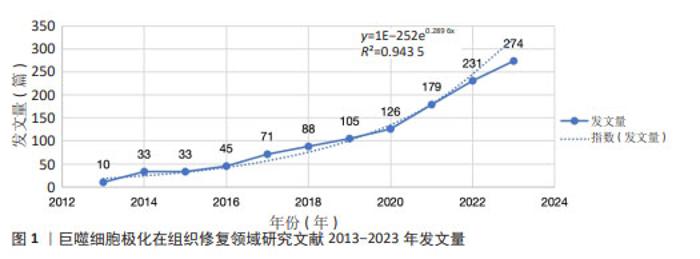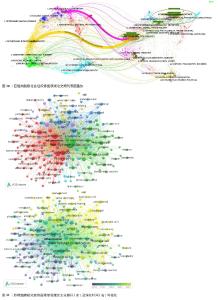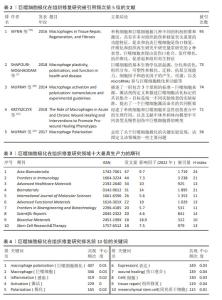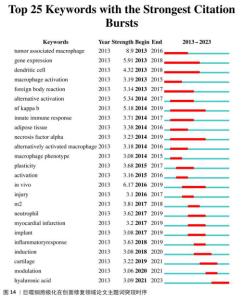Chinese Journal of Tissue Engineering Research ›› 2025, Vol. 29 ›› Issue (7): 1486-1496.doi: 10.12307/2025.032
Previous Articles Next Articles
Visualization analysis of macrophage polarization in tissue repair process
Chang Jinxia1, Liu Yufei1, Niu Shaohui2, Wang Chang1, Cao Jianchun3
- 1Beijing University of Chinese Medicine, Beijing 100029, China; 2Xiyuan Hospital of China Academy of Chinese Medical Sciences, Beijing 100091, China; 3Dongfang Hospital, Beijing University of Chinese Medicine, Beijing 100078, China
-
Received:2023-11-27Accepted:2024-02-19Online:2025-03-08Published:2024-06-28 -
Contact:Cao Jianchun, MD, Chief physician, Dongfang Hospital, Beijing University of Chinese Medicine, Beijing 100078, China -
About author:Chang Jinxia, MD candidate, Beijing University of Chinese Medicine, Beijing 100029, China -
Supported by:National Natural Science Foundation of China (General Program), No. 8187151877 (to CJC)
CLC Number:
Cite this article
Chang Jinxia, Liu Yufei, Niu Shaohui, Wang Chang, Cao Jianchun. Visualization analysis of macrophage polarization in tissue repair process[J]. Chinese Journal of Tissue Engineering Research, 2025, 29(7): 1486-1496.
share this article
Add to citation manager EndNote|Reference Manager|ProCite|BibTeX|RefWorks
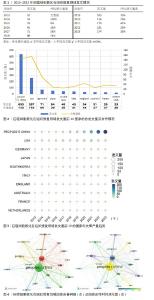
2.2 国家文章产出和相互合作分析 通过数据的可视化分析(图2,3),可以看出中国的发文量居于第一(642篇),是巨噬细胞极化在组织修复研究领域最大的贡献者,美国以257篇的发文量位居第二。从区域来看,亚洲以中国、日本、韩国为代表,欧洲以德国、意大利、英国为代表,北美洲以美国为主,还有大洋洲的澳大利亚都是该领域的重要贡献者。使用VOSviewer分析了不同国家之间的合作关系,并且绘制了合作网络及国家合作时间演化图(图4),最大的一组连接国家是由8个国家组成,根据连线粗细可以看出中国和美国的合作最紧密,美国的合作国家为最多其次为中国。中国的文章主要在2021年及以后出版,提示中国在该领域是新活跃的并且活跃程度很高。美国的文章出版平均年份为2019年,表明美国研究人员较早对该领域进行了关注并仍持续研究,其次德国、英国、新西兰、意大利的科研人员也较早对该领域进行了研究。"

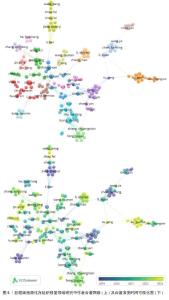
2.3 作者与共同作者分析 共有7 729名作者在研究巨噬细胞极化在组织修复领域做出了贡献。对发文量≥3篇的作者使用VOSviewer进行作者合著分析(图5),每个圆圈的大小代表作者的发文数量,更多的发文量产生更大的圆圈[18]。空军军事医科大学的Chen,Faming、西南交通大学的Feng,bo、高丽大学的Kang,Heemin所在团队,自该领域开始以来一直在从事此项研究工作,还有一些较新的研究人员,如Zhang,Chuangnian、Feng,Zujian、Liu,guohui、Chen,Lili。发文量最多的作者是来自南开大学的Kong, Deling(n=11),被引用次数最多的作者是来自Johns Hopkins University的Elisseeff,Hennifer H(n=741)。另外,还观察到了在该领域中贡献较大的18个团队,例如以南开大学Kong,Deling、西南交通大学Feng,Bo、中国医学科学院生物医学工程研究所Wang,Weiwei为核心的中国团队。 "

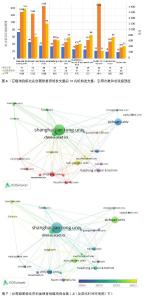
2.4 发文机构的分析 数据分析显示共有1 448个机构,上海交通大学的发文量居于首位,共发表了74篇文章(图6)。发文量最多的前5名都是中国的机构,分别是上海交通大学(n=74)、四川大学(n=46)、中国科学院(n=36)、浙江大学(n=34)、中山大学(n=32)。机构合著及演化时间图中(图7),线条越粗代表合作越紧密,圆圈越大代表发文量越多,其中上海交通大学与中国科学院的线条最粗,说明2个机构间的合作最密切。图中哈佛医学院、武汉大学、第四军医大学的平均发文在2020年左右。合作最密切的机构(前5名)分别是上海交通大学、中国科学院、南开大学、四川大学、哈佛医学院,总合作强度分别为139,98,66,61,60。引用次数最高的机构(前5名)分别是马什哈德医科大学、伊斯兰阿萨德大学、南京大学、中国科学院、上海交通大学,引用次数分别为2 395,2 257,1 914,1 828,1 626次。 "
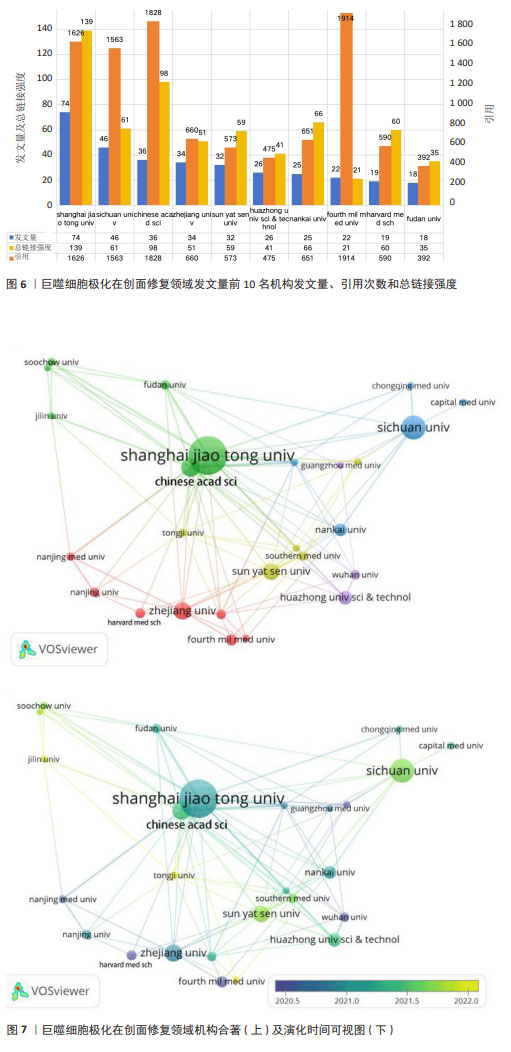
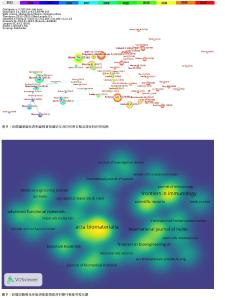
2.5 共同引用文献分析 共同引用文献参考分析表达文献之间的关系,考虑到引用的参考文献数量,参考文献的最小引用次数设置为14,共计分析所检索出的68篇文献。从图8可以看出,美国圣裘德儿童研究医院传染病和免疫学科Peter J Murray教授为该学科奠定了基础;罗格斯大学生物医学工程的Paulina Krzyszczyk教授、马什哈德医科大学布阿里研究所免疫学系医学院Abbas Shapouri-Moghaddam教授在该领域具有重要的影响力。被引前5文章的详细内容见表2。 2.6 期刊、共引期刊及期刊双图叠加分析 表3列出了10种最具生产力的期刊以及该期刊的ISSN、发文量、影响因子(2022年)、被引量、H-index。《Acta Biomaterialia》是最多产(n=47)及最具有影响力(H-inde=24)的期刊,《Advanced Functional Materials》的影响因子最高(19),其次是《Bioactive Materials》(18.9)。图9为共引期刊密度可视化图。 期刊双图叠加表示从引文期刊所在领域到被引文期刊所在领域之间的联系。期刊双图叠加(椭圆纵轴表示论文量,横轴表示作者数量)可以获得期刊的引用和被引矩阵,使用Citespace软件的Z scores功能[23],结果显示了2013-2023年发表文献的期刊与被引期刊之间的双层图谱。图10中有2条主要的信息流,提示研究发表的期刊及研究热点主要集中在分子生物学、免疫学、人工智能、材料、化学;文献引用主要来源于分子生物学、基因学、生物材料的期刊,表明这一领域为多学科交叉范畴,得到了多学科专家的重视,为巨噬细胞极化在组织修复的研究提供了理论及技术基础,也提示未来需要注重跨学科合作。 2.7 关键词共现、聚类及突现分析 关键词是对文章内容的高度凝练,在某领域中某个关键词共现频次越高提示可能是该领域的研究热点。以关键词为节点对文献数据进行可视化分析,数据分析获得的关键词共4 974个,通过VOSviewer对出现频率大于等于10次的关键词进行了共现,见图11,其中圆圈越大说明其在文章中出现的次数越多、频率最高,平均发文量大概是在2018年。通过分析可知“巨噬细胞极化(macrophage polarization)”“炎症(Inflammation)”“激活(Activation)”“修复 (Repair)”等关键词为该领域的热词,见表4,折射出国际该领域研究热点主要是巨噬细胞及巨噬细胞极化在组织修复和再生过程中尤其是炎症阶段及血管新生阶段的机制作用。炎症是组织修复的关键阶段,巨噬细胞极化涉及慢性炎症和重建稳态之间的平衡,其潜在机制目前尚不完全明确[24]。此外有研究提示,强大而动态的血管生成反应对创面修复至关重要[25],可提供所需的营养和氧气,巨噬细胞可在介导血管生成同时分泌调节因子影响新生内膜生长[26-27],目前被广泛认可的观点是M2表型通过合成血管生成生长因子与血管生成密切相关[28],具体机制仍需进一步研究。 "

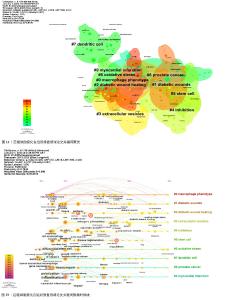
通过 Citespace 对关键词进行了编号聚类(图12),共分为了10大类,研究的Q=0.76、S=0.88这2个数值均达到了标准,说明此次数据分析合理[29]。结果显示目前已经形成10个热点研究领域:“#0:巨噬细胞表型”“#1:糖尿病创面”“#2:糖尿病创面愈合”“#3:细胞外囊泡”“#4:抑制”“#5:干细胞”“#6:氧化应激”“#7:树突状细胞”“#8:前列腺癌”“#9:心肌梗死”。 对聚类的关键词从时间线上进行分析(图13),可以看出每个关键词的出现在其年份的研究情况。关键词突现能够反映时间段内兴起的或者持续受到关注的研究热点,反映研究领域内的热点变化及趋势。研究共分析得出25个爆发词,如图14所示,2013-2023年爆发性较强的关键词包括“感应”“软骨”“调节”“透明质酸”等,代表了新兴趋势。 "

| [1] DAS A, SINHA M, DATTA S, et al. Monocyte and macrophage plasticity in tissue repair and regeneration. Am J Pathol. 2015; 185(10):2596-2606. [2] ZHANG Q, RAOOF M, CHEN Y, et al. Circulating mitochondrial DAMPs cause inflammatory responses to injury. Nature. 2010;464(7285):104-107. [3] WYNN TA. Cellular and molecular mechanisms of fibrosis. J Pathol. 2008; 214(2):199-210. [4] WYNN TA, BARRON L. Macrophages: master regulators of inflammation and fibrosis. Semin Liver Dis. 2010;30(3): 245-257. [5] MITCHELL S, THOMAS G, HARVEY K, et al. Lipoxins, aspirin-triggered epi-lipoxins, lipoxin stable analogues, and the resolution of inflammation: stimulation of macrophage phagocytosis of apoptotic neutrophils in vivo. J Am Soc Nephrol. 2002;13(10):2497-2507. [6] KLUTH DC. Pro-resolution properties of macrophages in renal injury. Kidney Int. 2007;72(3):234-236. [7] SHAPOURI-MOGHADDAM A, MOHAMMADIAN S, VAZINI H, et al. Macrophage plasticity, polarization, and function in health and disease. J Cell Physiol. 2018;233(9):6425-6440. [8] KHARAZIHA M, BAIDYA A, ANNABI N. Rational design of immunomodulatory hydrogels for chronic wound healing. Adv Mater. 2021;33(39):e2100176. [9] LI L, CAO J, LI S, et al. M2 macrophage-derived sEV regulate pro-inflammatory CCR2+ macrophage subpopulations to favor post-AMI cardiac repair. Adv Sci (Weinh). 2023;10(14):e2202964. [10] WANG Y, LI C, WAN Y, et al. Quercetin-loaded ceria nanocomposite potentiate dual-directional immunoregulation via macrophage polarization against periodontal inflammation. Small. 2021; 17(41):e2101505. [11] MOREIRA LOPES TC, MOSSER DM, GONÇALVES R. Macrophage polarization in intestinal inflammation and gut homeostasis. Inflamm Res. 2020;69(12): 1163-1172. [12] WANG C, MA C, GONG L, et al. Macrophage Polarization and Its Role in Liver Disease. Front Immunol. 2021;12:803037. [13] 陈悦,刘则, 陈劲,等.科学知识图谱的发展历程[J].科学学研究,2008,26(3):449-460. [14] CHEN C. CiteSpace II: Detecting and visualizing emerging trends and transient patterns in scientific literature. J Am Soc Inf Sci Technol. 2006;57(3):359-377. [15] 高凯.文献计量分析软件VOSviewer的应用研究[J].科技情报开发与经济,2015, 25(12): 95-98. [16] NIU SH, LI B, GU HC, et al. Knowledge mapping of extracellular vesicles in wound healing: a bibliometric analysis (2002-2022). Int Wound J. 2023;20(8): 3221-3240. [17] VAN ECK NJ, WALTMAN L. Software survey: VOSviewer, a computer program for bibliometric mapping. Scientometrics. 2010;84(2):523-538. [18] JIANG S, LIU Y, ZHENG H, et al. Evolutionary patterns and research frontiers in neoadjuvant immunotherapy: a bibliometric analysis. Int J Surg. 2023; 109(9):2774-2783. [19] WYNN TA, VANNELLA KM. Macrophages in Tissue Repair, Regeneration, and Fibrosis. Immunity. 2016;44(3):450-462. [20] MURRAY PJ, ALLEN JE, BISWAS SK, et al. Macrophage activation and polarization: nomenclature and experimental guidelines. Immunity. 2014;41(1):14-20. [21] KRZYSZCZYK P, SCHLOSS R, PALMER A, et al. The Role of Macrophages in Acute and Chronic Wound Healing and Interventions to Promote Pro-wound Healing Phenotypes. Front Physiol. 2018;9:419. [22] MURRAY PJ. Macrophage Polarization. Annu Rev Physiol. 2017;79:541-566. [23] 曾子玲,佟琳,刘思鸿,等.基于CiteSpace知识图谱的麦冬研究热点与趋势分析[J].中国中药杂志,2021,46(24): 6549-6557. [24] MURRAY PJ, WYNN TA. Protective and pathogenic functions of macrophage subsets. Nat Rev Immunol. 2011;11(11): 723-737. [25] DIPIETRO LA. Angiogenesis and wound repair: when enough is enough. J Leukoc Biol. 2016;100(5):979-984. [26] NOSRATI H, ARAMIDEH KHOUY R, NOSRATI A, et al. Nanocomposite scaffolds for accelerating chronic wound healing by enhancing angiogenesis. J Nanobiotechnol. 2021;19(1):1. [27] GUREVICH DB, SEVERN CE, TWOMEY C, et al. Live imaging of wound angiogenesis reveals macrophage orchestrated vessel sprouting and regression. Embo J. 2018; 37(13):e97786. [28] XIONG Y, LIN Z, BU P, et al. A whole-course-repair system based on neurogenesis-angiogenesis crosstalk and macrophage reprogramming promotes diabetic wound healing. Adv Mater. 2023;35(19):e2212300. [29] 陈悦,陈超美,刘则渊,等.CiteSpace知识图谱的方法论功能[J].科学学研究, 2015,33(2):242-253. [30] SICA A, MANTOVANI A. Macrophage plasticity and polarization: in vivo veritas. J Clin Invest. 2012;122(3):787-795. [31] BECKER M, DE BASTIANI MA, PARISI MM, et al. Integrated transcriptomics establish macrophage polarization signatures and have potential applications for clinical health and disease. Sci Rep. 2015;5:13351. [32] BOSCO MC. Macrophage polarization: reaching across the aisle? J Allergy Clin Immunol. 2019;143(4):1348-1350. [33] WYNN TA, CHAWLA A, POLLARD JW. Macrophage biology in development, homeostasis and disease. Nature. 2013; 496(7446):445-455. [34] MOSSER DM, EDWARDS JP. Exploring the full spectrum of macrophage activation. Nat Rev Immunol. 2008;8(12):958-969. [35] FU B, XIONG Y, SHA Z, et al. SEPTIN2 suppresses an IFN-γ-independent, proinflammatory macrophage activation pathway. Nat Commun. 2023;14:7441. [36] SAMPATH P, PERIYASAMY KM, RANGANATHAN UD, et al. Monocyte and macrophage miRNA: potent biomarker and target for host-directed therapy for tuberculosis. Front Immunol. 2021;12: 667206. [37] SCALA P, REHAK L, GIUDICE V, et al. Stem Cell and Macrophage Roles in Skeletal Muscle Regenerative Medicine. Int J Mol Sci. 2021;22(19):10867. [38] MIRZA RE, FANG MM, ENNIS WJ, et al. Blocking interleukin-1β induces a healing-associated wound macrophage phenotype and improves healing in type 2 diabetes. Diabetes. 2013;62(7):2579-2587. [39] LIU Y, XIA G, CHEN Y, et al. Purpurolide C-based microneedle promotes macrophage-mediated diabetic wound healing via inhibiting TLR4-MD2 dimerization and MYD88 phosphorylation. Acta Pharm Sin B. 2023;13(12):5060-5073. [40] YU B, QIN SY, HU BL, et al. Resveratrol improves CCL4-induced liver fibrosis in mouse by upregulating endogenous IL-10 to reprogramme macrophages phenotype from M(LPS) to M(IL-4). Biomed Pharmacother. 2019;117:109110. [41] YANG P, PENG Y, DAI X, et al. Bionic peptide scaffold in situ polarization and recruitment of M2 macrophages to promote peripheral nerve regeneration. Bioact Mater. 2023; 30:85-97. [42] WANG D, HU Y, ZHANG L, et al. Dual delivery of an NF-κB inhibitor and IL-10 through supramolecular hydrogels polarizes macrophages and promotes cardiac repair after myocardial infarction. Acta Biomater. 2023;164:111-123. [43] VANNELLA KM, WYNN TA. Mechanisms of Organ Injury and Repair by Macrophages. Annu Rev Physiol. 2017;79:593-617. [44] LAZAROV T, JUAREZ-CARREÑO S, COX N, et al. Physiology and diseases of tissue-resident macrophages. Nature. 2023;618(7966):698-707. [45] KUGELBERG E. Tissue repair: Biological scaffolds modulate immune cells. Nat Rev Immunol. 2016;16(5):276-277. [46] SADTLER K, ESTRELLAS K, ALLEN BW, et al. Developing a pro-regenerative biomaterial scaffold microenvironment requires T helper 2 cells. Science. 2016;352(6283):366-370. [47] 中华医学会糖尿病学分会,中华医学会感染病学分会,中华医学会组织修复与再生分会.中国糖尿病足防治指南(2019版)(Ⅰ)[J].中华糖尿病杂志,2019,11(2):92-108. [48] QIAN Y, ZHENG Y, JIN J, et al. Immunoregulation in diabetic wound repair with a photoenhanced glycyrrhizic acid hydrogel scaffold. Adv Mater. 2022; 34(29):e2200521. |
| [1] | Liang Haobo, Wang Zeyu, Ma Wenlong, Liu Hao, Liu Youwen. Hot issues in the field of joint revision: infection, rehabilitation nursing, bone defect, and prosthesis loosening [J]. Chinese Journal of Tissue Engineering Research, 2025, 29(9): 1963-1971. |
| [2] | Wang Wentao, Hou Zhenyang, Wang Yijun, Xu Yaozeng. Apelin-13 alleviates systemic inflammatory bone loss by inhibiting macrophage M1 polarization [J]. Chinese Journal of Tissue Engineering Research, 2025, 29(8): 1548-1555. |
| [3] | Lyu Liting, Yu Xia, Zhang Jinmei, Gao Qiaojing, Liu Renfan, Li Meng, Wang Lu. Bibliometric analysis of research process and current situation of brain aging and exosomes [J]. Chinese Journal of Tissue Engineering Research, 2025, 29(7): 1457-1465. |
| [4] | Xie Liugang, Cui Shuke, Guo Nannan, Li Aoyu, Zhang Jingrui. Research hotspots and frontiers of stem cells for Alzheimer’s disease [J]. Chinese Journal of Tissue Engineering Research, 2025, 29(7): 1475-1485. |
| [5] | Li Jialin, Zhang Yaodong, Lou Yanru, Yu Yang, Yang Rui. Molecular mechanisms underlying role of mesenchymal stem cell secretome [J]. Chinese Journal of Tissue Engineering Research, 2025, 29(7): 1512-1522. |
| [6] | Li Huijun, Li Huangyan, Zhang Yeting. Physical activity and cognition in older adults: research hotspot and topic evolution [J]. Chinese Journal of Tissue Engineering Research, 2025, 29(5): 1073-1080. |
| [7] | Zhang Yu, Xu Ruian, Fang Lei, Li Longfei, Liu Shuyan, Ding Lingxue, Wang Yuexi, Guo Ziyan, Tian Feng, Xue Jiajia. Gradient artificial bone repair scaffold regulates skeletal system tissue repair and regeneration [J]. Chinese Journal of Tissue Engineering Research, 2025, 29(4): 846-855. |
| [8] | Dang Xiaowen, Huang Hailiang, Huang Lei, Wang Yajie . Research frontiers and hotspots of carbon nanomaterials in biomedical field over the past 10 years [J]. Chinese Journal of Tissue Engineering Research, 2025, 29(4): 752-760. |
| [9] | Wang Sifan, He Huiyu, Yang Quan, Han Xiangzhen. miRNA-378a overexpression of macrophage cell line composite collagen sponge: anti-inflammation and tissue repair promotion [J]. Chinese Journal of Tissue Engineering Research, 2025, 29(4): 789-799. |
| [10] | Zhao Jianwei, Li Xunsheng, Lyu Jinpeng, Zhou Jue, Jiang Yidi, Yue Zhigang, Sun Hongmei. Deer antler stem cell exosome composite hydrogel promotes the repair of burned skin [J]. Chinese Journal of Tissue Engineering Research, 2025, 29(34): 7344-7352. |
| [11] | Ma Yucong, Ouyang Zhengzheng, Liu Xiaojie, Yang Sifei. Tracking of research trends and hotspots in medical magnesium alloy materials [J]. Chinese Journal of Tissue Engineering Research, 2025, 29(34): 7470-7480. |
| [12] | Wang Yong, Li Hongyu, Liu Yuhang, Wang Fengxing. Knowledge map of surgical treatment for osteonecrosis of the femoral head: a bibliometric analysis of data from 2005 to 2024 [J]. Chinese Journal of Tissue Engineering Research, 2025, 29(33): 7250-7260. |
| [13] | Deng Qing, Wang Qingjun, Zhang Yeting. Visual analysis of dynamic evolution of research topics in the field of physical activity and hippocampal tissue [J]. Chinese Journal of Tissue Engineering Research, 2025, 29(32): 6997-7003. |
| [14] | Yao Lanxuan, Wang Xuefei, Liu Yang, Yang Yujia, Zhao Yi, Qi Fangfang, Li Yinghui . Mesenchymal stem cells and their derived extracellular vesicles target macrophages to intervene in autoimmune diseases [J]. Chinese Journal of Tissue Engineering Research, 2025, 29(31): 6772-6781. |
| [15] | Xiong Zhenghua, Zhou Jianghong, Shen Yi, Han Xuesong . Mesenchymal stem cells and extracellular vesicles in repair of endometrial injury [J]. Chinese Journal of Tissue Engineering Research, 2025, 29(31): 6782-6791. |
| Viewed | ||||||
|
Full text |
|
|||||
|
Abstract |
|
|||||
